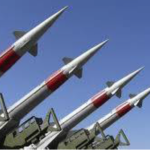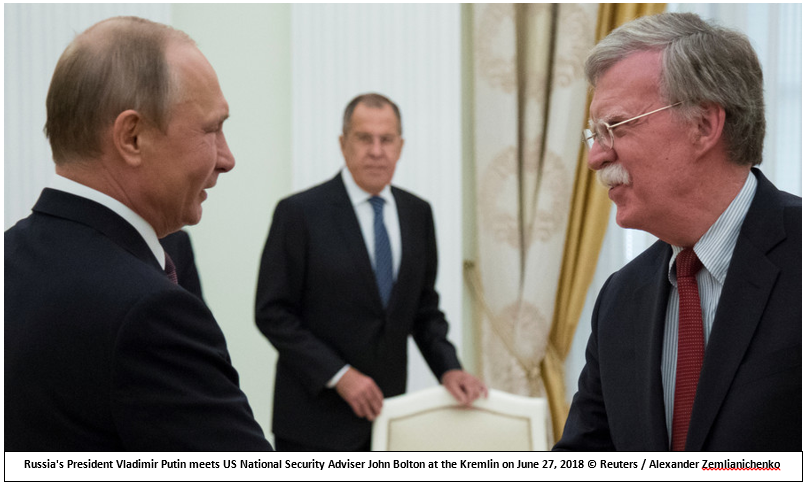National Security Advisor John Bolton’s trip to Moscow received much public fanfare following President Trump’s announced plan to withdraw from the INF Treaty that Russia has been violating for years, with little or no U.S. response — hopefully he has reset the entire arms control agenda from recent administrations and we are returning to Ronald Reagan’s Peace Through Strength agenda in dealing not only with Russia but also China and others.
This is not Ambassador Bolton’s “first rodeo,” and his related longstanding views are well known. Click here for an interesting and prophetic June 21, 2013 Foreign Policy article by John Bolton and Paula DeSutter, discussing the then already increasingly apparent failures of the Obama administration’s approach to arms control. No doubt many of the same themes are being included in his discussions in Moscow.
Yours truly was intimately involved in the negotiations for the historically important INF Treaty, signed by President Ronald Reagan and Soviet General Secretary Mikhail Gorbachev in the 1987 Washington Summit. It set a new standard in intrusive verification methods that met Reagan’s “Trust but verify” demand in eliminating a whole class of intermediate and short range nuclear armed missiles — at least for the Soviet Union and the United States. My role in the Nuclear and Space Talks (NST) was focused on defending President Reagan’s Strategic Defense Initiative (SDI) which was the target of the Soviet negotiations.
Click here for last week’s discussion of these negotiations, particularly in the context of the 1986 Reykjavik Summit — which remains pertinent still, especially since it set the stage for both INF and Strategic Arms Reduction Talks (START) Treaties that were the first arms control agreements ever actually to reduce nuclear arms.
While a full complement of issues may come up in Bolton’s meetings in Moscow, the primary focus will likely be on the INF Treaty and its failing relevance to the current geopolitical situation — especially given President Trump’s announced intention to withdraw from its terms.
Today, not only is Russia violating those terms, but China is building its own INF missiles and the United States cannot respond in kind because of the INF Treaty. As the Former Commander of Pacific Command (PACOM) and now our Ambassador to South Korea, Harry Harris, recently observed: “We have no ground-based capability that can threaten China because of, among other things, our rigid adherence, and rightly so, to the . . . INF Treaty.” Click here for Bill Gertz’s Washington Times article that discusses the context of the growing threat from China that demands our attention.
Moreover, the July 1991 START Treaty was also based on the same high verification standards, but they were lost in the February 2011 New START Treaty that also reopened doors that were closed in 1991.
Of particular interest to me is the fact that New START’s terms incentivized again the destabilizing role of multiple independent reentry vehicles “MIRVs” carried by very large intercontinental ballistic missiles (ICBMs) — and now large Russian ICBMs again can carry 10 or more nuclear weapons — a condition eliminated by the 1991 START Treaty.
Moreover, New START’s “bomber counter rule” counts each bomber as a single nuclear weapon, no matter how many bombs/or other missiles it carries — including potentially the hypervelocity missiles that Vladimir Putin has boasted about.
While withdrawing from the INF Treaty as President Trump has announced, START offensive arms control conditions also need a major do-over. Hopefully, Bolton’s discussions will also deal with these important matters.
And there was another component of Ronald Raegan’s Nuclear and Space Talks (NST) agenda that also needs an update. In those days, it was the role of his Strategic Defense Initiative (SDI) — especially U.S. efforts to exploit space-based defenses — that provided great negotiating leverage.
Click here for my recent Newsmax article that reviewed how, at the 1986 Reykjavik “summit to plan a Summit,” President Reagan’s insistence on continuing his SDI efforts eventually to build space based defenses led to the first arms control agreements actually to reduce nuclear arms.
Today, President Trump’s Space Force initiative can provide similar negotiating leverage, but like Reagan at Reykjavik, President Trump must not negotiate away that important initiative.
Indeed, it is needed to counter the near-term hypersonic threat posed especially by Russia and China. Click here for a useful article describing what constitutes the hypersonic threat and why it is difficult to counter — currently impossible to counter with our existing ballistic missile defense (BMD) systems.
The nearest term hypersonic threat is likely to be launched as a payload on rockets and then deployed high in the atmosphere as a maneuvering vehicle to evade our ballistic missile defense (BMD) systems. Such a capability is well understood, and was referred to in the 1970s as a maneuvering reentry vehicle (MARV) then intended to counter nuclear armed BMD systems.
To counter this near term hypersonic threat, we can and should build space-based interceptors (SBIs) as soon as possible to intercept these missiles in their boost phase from anyplace on earth, while their rockets are burning brightly and before they can release their payloads. Click here for my Newsmax discussion of the fact that we have known how to do this since the latter stages of the SDI era (1983-93), before the Clinton administration gutted the SDI program in early 1993.
And click here for my Newsmax discussion that indicates such BMD systems built using today’s technology would be relatively inexpensive, especially in the context of what we currently spend on much less cost-effective defenses against the growing threat.
Undersecretary of Defense for Research and Engineering Mike Griffin has warned that we are playing “catch-up” against hypersonic threats. And as a first rate aerospace engineer, former NASA Administrator, and SDI leader, he well understands the technology and management challenges to deploy cost-effective SBIs.
Indeed, he led technology developments in the 1980s that helped enable Brilliant Pebbles, the most cost-effective SBI system of the SDI era (1983-93), that was cancelled by the Clinton administration in early 1993 and has since remained dormant.
We judged then that such a system could be developed, deployed and operated for 20 years for $10-billion in 1988 dollars — now inflated to about $20 billion. Click here for a discussion by senior officials who led those developments and associated cost estimates that were fully approved by the Pentagon’s top acquisition executives.
Actually, the costs should be even less today, because of advances in technology that enables numerous small satellite applications being increasingly demonstrated. Click here for pertinent background from the private sector.
Whatever, there are important parallels to the negotiations during the administrations of Ronald Reagan and George H.W. Bush that were lost subsequently and need to be reinstated. Space again can provide significant negotiating leverage, but must not be negotiated away.
The development of such a space based defense capability will again show Russia’s wasted effort of very large highly MIRVed ballistic missiles. And it will illustrate an early counter to Putin’s boasts of achieving hypersonic capability that would defeat our current BMD systems.
The legacy of the agreements President Trump inherited does not support that objective — indeed they are counterproductive. Hopefully, National Security Advisor Bolton’s visit to Moscow will set the stage for ending them and begin repeating the era that produced truly verifiable agreements to deal with today’s problems.
Bottom Lines:
Hopefully, the National Security Advisor’s stop in Moscow will bear fruit as he retreads paths most memorably pursued during the Reagan years. We should know by this day’s end.
This time, we know how to build cost-effective space-based BMD systems, which are urgently needed to counter growing threats — from Russia’s existing highly Mirved ballistic missiles and the earliest of Putin’s hypersonic missiles.
But we can anticipate the longstanding objections of arms control zealots who are more interested in pursuing agreements while ignoring our national security needs.
Not the least of these issues “where the rubber meets the road” will be ill-placed concerns about the “militarization of space” that could politically block our efforts to build the space based defenses we need.
Stay Tuned.
What can you do?
Join us in praying for our nation, and for a rebirth of the freedom sought, achieved and passed to us by those who came before us.
Help us to spread our message to the grass roots and to encourage all “powers that be” to provide for the common defense as they are sworn to do.
Begin by passing this message to your friends and suggest they visit our webpage www.highfrontier.org, for more information. Also, please encourage your sphere of influence to sign up for our weekly e-newsletter.
Encourage them to review our past email messages, posted on www.highfrontier.org, to learn about many details related to the existential manmade and natural EMP threats and how we can protect America against them. I hope you will help us with our urgently needed efforts, which I will be discussing in future messages.
Click here to make a tax deductible gift. If you prefer to mail a check, Please send it High Frontier, 20 F Street 7th Floor, Washington, DC 20001.
E-Mail Message 181023
Please click here to read Past Weekly Updates!
Please help High Frontier continue this important and timely work!
Be sure to follow us on our Social Sites!
If you found this letter via our Social Sites, and you would like to subscribe, please click below!






